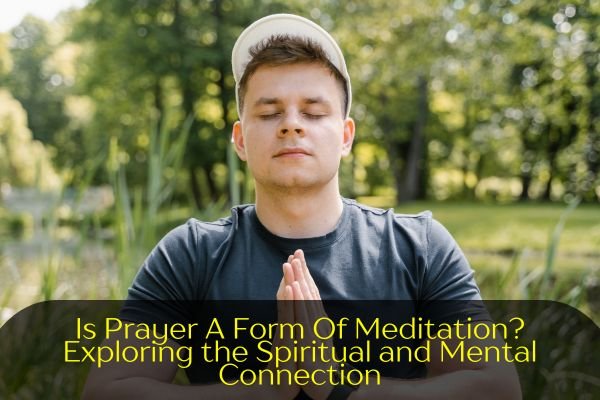Prayer and meditation are two ancient practices that cut across cultures and religions worldwide. Both are often associated with spirituality, inner peace, and mental well-being, yet they are usually perceived as distinct activities. Prayer is traditionally understood as a form of communication with a divine being or higher power, while meditation is generally regarded as a technique for focusing the mind and achieving mindfulness or relaxation.
Despite these apparent differences, many people and scholars have questioned whether prayer can be considered a form of meditation, given the similarities in their processes and effects. In this article, I took a closer look at the nature of both prayer and meditation, examining their definitions, purposes, and impacts.
By understanding the commonalities and distinctions between the two, we can gain insight into how they influence the human experience and whether prayer fits within the broader concept of meditation. This article expounds the essence of each practice, highlight their similarities and differences, and consider perspectives from religious traditions and scientific research to provide a comprehensive view of the question: Is prayer a form of meditation?
Understanding Prayer
Prayer is a practice rooted in the desire to communicate with a higher power, deity, or spiritual force. It is often seen as an expression of faith, devotion, and surrender. People pray for many reasons: to seek guidance, express gratitude, ask for help, or find comfort in difficult times. Prayer can take many forms, such as spoken words, silent thoughts, chanting, or even physical gestures like kneeling or bowing. Different religious traditions emphasize different styles of prayer, from structured liturgies to spontaneous, personal conversations with the divine.
Importantly, prayer is typically directed outward — it involves reaching out beyond oneself to connect with something greater. While some prayers are verbal requests or praises, others, like contemplative prayer, focus more on quieting the mind and opening oneself to divine presence. This variety means that prayer is not a singular activity but a broad spectrum of practices, all sharing a common thread of spiritual connection and intentionality.
Understanding Meditation
Meditation, on the other hand, is a practice primarily focused on training the mind to achieve clarity, calmness, and heightened awareness. It encompasses a wide range of techniques aimed at directing attention inward, such as mindfulness meditation, focused attention on a mantra or breath, and transcendental meditation. Meditation often involves sitting quietly and observing thoughts, sensations, or emotions without judgment, fostering a state of mental stillness and presence.
Unlike prayer, meditation does not necessarily involve communication with a deity or spiritual being; it can be entirely secular. Many meditate for relaxation, stress reduction, or improved concentration. However, meditation also has deep roots in spiritual traditions such as Buddhism and Hinduism, where it is a path to enlightenment or self-realization. Regardless of its form, meditation is about cultivating awareness and being fully present in the moment.
Similarities Between Prayer and Meditation
Despite their differing origins and intentions, prayer and meditation share several fundamental characteristics. Both practices involve focused attention, whether it’s on a divine presence, a specific thought, a mantra, or the breath. This focus helps quiet the mind and draw attention away from distractions, allowing practitioners to enter a state of inner stillness. In both practices, repetition is common — whether through repeated prayers like the Rosary or repeated mantras in meditation — helping to anchor attention and promote a sense of rhythm and calm.
Physiologically, prayer and meditation often produce similar effects. Scientific studies have shown that both can reduce stress, lower blood pressure, and induce a relaxation response in the body. Emotionally, they can foster feelings of peace, gratitude, compassion, and connection — whether to a higher power, oneself, or the universe. Many people also use both practices as tools for self-reflection, introspection, and coping with life’s challenges. In this way, prayer and meditation can be viewed as parallel paths to inner harmony and well-being.
Differences Between Prayer and Meditation
While the similarities are notable, the differences between prayer and meditation are just as significant. The most obvious distinction lies in their direction and intent. Prayer is typically outwardly directed — it involves reaching out to a higher power, asking for intervention, giving thanks, or seeking forgiveness. It is often rooted in the belief that there is someone or something listening. Meditation, in contrast, is generally inwardly focused. Its goal is often to observe or still the mind, cultivate awareness, or achieve mental clarity, rather than to communicate with an external force.
Another key difference is the role of belief. Prayer is usually embedded within a religious or spiritual framework and requires some level of belief in a divine presence. Meditation, while it can be spiritual, does not require any specific beliefs and is widely practiced in secular contexts. Additionally, the structure and ritual of prayer — often guided by religious texts or traditions — contrasts with the more open-ended, often individualistic nature of meditation practices. These distinctions highlight the different philosophical and experiential roots of each practice, even as they occasionally overlap in practice and effect.
Perspectives from Religious and Spiritual Traditions
Across the world’s religious traditions, prayer and meditation often coexist, and in some cases, the boundaries between them blur. In Christianity, for example, while prayer is typically verbal and directed toward God, there is also a rich tradition of contemplative prayer — a silent, inward-focused practice aimed at experiencing the presence of God beyond words. Christian mystics like St. Teresa of Ávila and St. John of the Cross describe prayer in ways that closely resemble meditative states, emphasizing stillness, surrender, and union with the divine.
In Eastern traditions, particularly Buddhism and Hinduism, meditation is central. However, prayer also plays a role — such as chanting mantras, offering prayers to deities, or reciting scriptures. These practices often serve both devotional and meditative purposes. In Islam, prayer (salat) is a structured, ritual act performed five times daily, combining physical movement, recitation, and mindfulness — a rhythm that can foster a meditative mindset. Even in indigenous and tribal religions, prayer often incorporates rhythmic chanting, drumming, or quiet reflection, all of which carry meditative elements. These examples illustrate how prayer and meditation are often intertwined in spiritual life, each enriching the other.
Scientific and Psychological Views
Modern science has taken a growing interest in both prayer and meditation, particularly regarding their effects on mental and physical health. Numerous studies have found that both practices can reduce stress, alleviate symptoms of anxiety and depression, and improve overall emotional well-being. Brain imaging research shows that both prayer and meditation activate similar areas of the brain, such as those associated with attention, empathy, and emotional regulation. This suggests that the mechanisms behind both practices may overlap more than previously thought.
From a psychological perspective, both prayer and meditation provide a sense of purpose, connection, and coping — all of which contribute to mental resilience. Prayer can instill hope and provide emotional support through belief in a higher power, while meditation encourages mindfulness and acceptance of the present moment. Therapies like mindfulness-based stress reduction (MBSR) and spiritually-integrated psychotherapy often draw on elements from both traditions to support mental health. These findings reinforce the idea that, regardless of one’s beliefs, both practices can be powerful tools for enhancing psychological well-being.
Conclusion
Prayer and meditation, though rooted in different traditions and intentions, share a profound intersection in their pursuit of inner peace, clarity, and connection. Both practices lead individuals into a state of reflection and focused stillness that can be emotionally enriching and spiritually transformative. Scripture supports this union of heart and mind: “Be still, and know that I am God” (Psalm 46:10) speaks to the contemplative quiet that both prayer and meditation encourage.
Whether it is a whispered prayer or silent breathwork, the outcome often draws people closer to a place of calm, awareness, and divine presence. The overlapping benefits — from peace of mind to spiritual renewal — reveal that the line separating these practices may be more symbolic than substantial.
Whether prayer qualifies as a form of meditation may ultimately depend on one’s perspective and experience. To some, prayer is an act of communication with God, shaped by devotion and faith, as echoed in Philippians 4:6: “Do not be anxious about anything, but in every situation, by prayer and petition, with thanksgiving, present your requests to God.” To others, especially those engaging in practices like contemplative prayer or meditative Scripture reading, prayer becomes deeply meditative, focused on stillness and divine presence.







